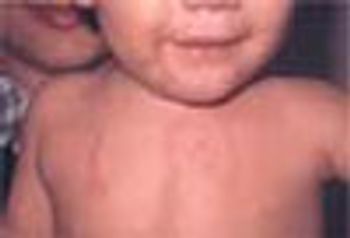
The parents of a 2-month-old infant were concerned about a gradually enlarging reddish mass in the inner canthus of their daughter's left eye. The 3-cm mass had been present for several weeks. It became engorged when the child cried or strained.

The parents of a 2-month-old infant were concerned about a gradually enlarging reddish mass in the inner canthus of their daughter's left eye. The 3-cm mass had been present for several weeks. It became engorged when the child cried or strained.

A 2-year-old African American boy was brought for evaluation of symptoms of an upper respiratory tract infection and intermittent abdominal pain.

This day-old, macular, blanching, nonpruritic rash had developed in the right axilla and on the right arm and right side of the trunk of a 3 1/2-year-old boy. He was otherwise asymptomatic. Other physical examination findings were unremarkable.

A 9-year-old Hispanic boy presented with submental swelling and dysphagia. The swelling had progressed over 5 days. He had no history of fever, difficulty in breathing, or voice change.

The mother of a young child was concerned about these hyperpigmented streaks that had appeared on her son's upper chest during the previous 2 weeks. Initially, the streaks were erythematous. They were completely asymptomatic, and the child was otherwise healthy and taking no medications.

Gonorrhea (aka "the clap," or "the drip") is caused by sexually transmitted Neisseria gonorrhoeae--a Gram-negative diplococcus. One of the most common reportable diseases in the United States, gonorrhea frequently affects sexually active adolescents. Approximately 30% of the 350,000 annual cases involve 15- to 19-year-olds. (That percentage is thought to be an underestimate!) Those most often infected are young women 15 to 24 years old. Recent data suggest that infection rates are higher among teens who are homeless or pregnant, and in those from a minority group or an economically disadvantaged background.

A 30-hour-old boy--born to a 36-year-old gravida 3, para 3, at full term via a spontaneous vaginal delivery--was noted to a have a mildly distended abdomen while in the newborn nursery. He had been breast-feeding every 2 to 3 hours and initially was spitting up about a quarter of the volume he had consumed. During the last 3 or 4 feedings, he had been spitting up most of the milk. There was no bilious emesis. He had not passed meconium.

Millions enjoy skiing, snowboarding, and sledding. These cold weather activities--while exhilarating--also cause many injuries, each with distinct clinical characteristics.

Your patient, Keith, is a 19-year-old college freshman who is currently on spring break following the successful completion of his midterm exams. You have known him since he was 9 years old and you are looking forward to hearing about his first few months away at school.

I was asked to see this child by her physician who was concerned that these lesions were a neoplastic event. The physician wanted a dermatologist's opinion and a biopsy to guide treatment decisions. Needless to say, the child's parents were distraught. The child was happy, playful, and not at all disturbed by the rash.

Can you identify this asymptomatic lesion on the neck of a healthy 14-year-old boy?